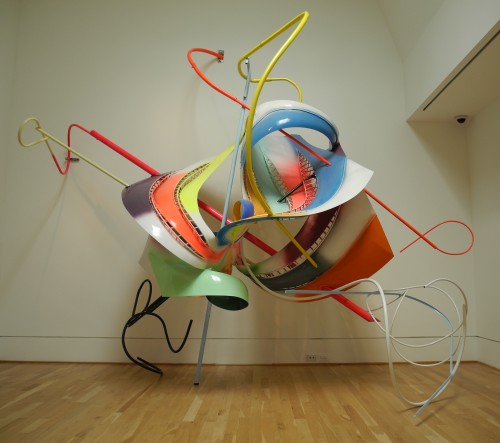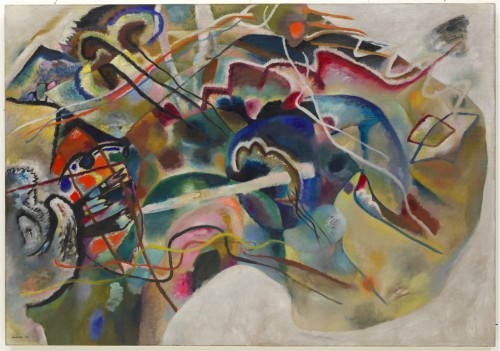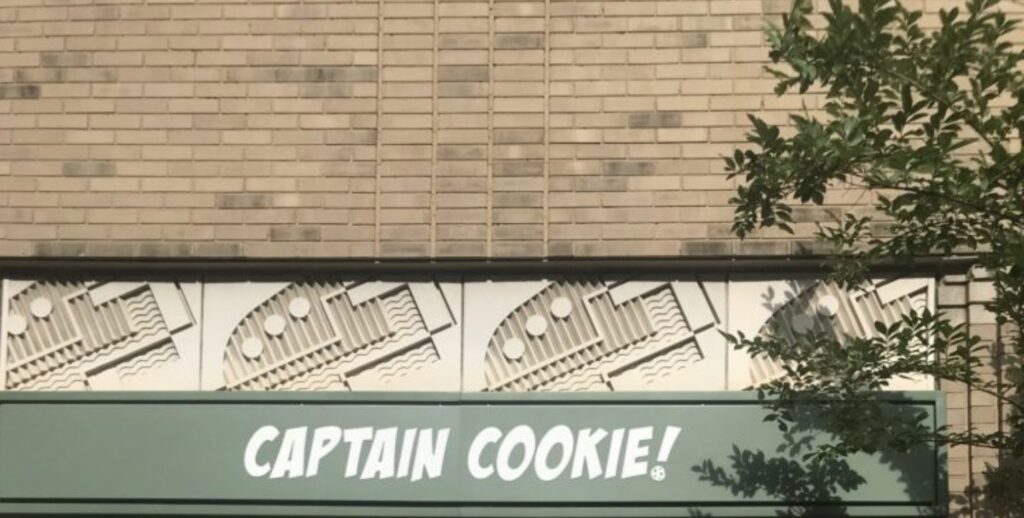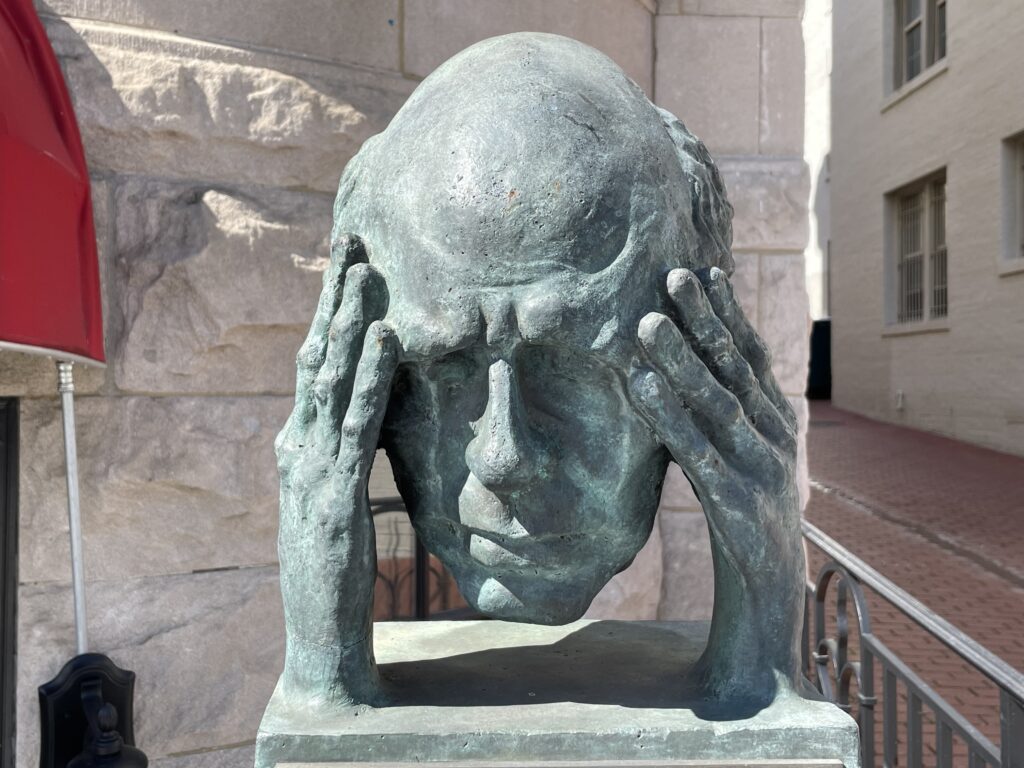
Frank Stella, K. 43 (lattice variation), 2008. Photo by Beth Shook.
As a supplement to the Weekly Art Lens, this summer I’ll be contributing occasional long-form reviews of noteworthy exhibitions. Hopefully Fixed Focus will offer an opportunity for dialogue about D.C.’s vibrant and often underrated visual arts scene. The Phillips Collection, which is now celebrating its 90th anniversary as the first modern art museum in the country, seemed like the natural place to start.
The larger of two exhibitions opening Saturday at the Phillips, Kandinsky and the Harmony of Silence: Painting with White Border, is the product of both curatorial ingenuity and luck. From its early stages, the exhibition was centered on one of the museum’s own works by Russian painter Wassily Kandinsky, Sketch I for Painting with White Border. The preparatory oil sketch was made for an important 1913 painting now owned by the Guggenheim in New York. When Phillips Curator Elsa Smithgall contacted the Guggenheim about borrowing their painting, her timing could not have been better. The Guggenheim had just received funding for a full conservation study and treatment of that very work. Collaboration between the two museums was the logical next step.
The resulting exhibition offers both a fascinating glimpse into the modernist’s working process and something of an art historical mystery. The first gallery on the museum’s third floor prominently features the newly restored painting from the Guggenheim, as well as the Phillips’ work, known as Sketch I for Painting with White Border, and some early preparatory sketches. Inspired by a recent return to his native Moscow, Painting with White Border marked an important moment in Kandinsky’s artistic trajectory. The painterly composition blooms from the canvas with color and dynamism, framed on two sides by a white border. (The exhibition title comes from the artist’s characterization of the color white as “harmony of silence … one pregnant with possibilities.”) Within the waves of color and the wispy lines that wind through them, the focal point of the painting is a blue mass connected by a thick white line to what appears to be a set of black appendages. It suggests some kind of action, but what?
Continues after the jump.

Wassily Kandinsky, Painting with White Border (Moscow), 1913. Oil on canvas, 55 1/4 x 78 7/8 in. Solomon R. Guggenheim Museum, New York, Solomon R. Guggenheim Founding Collection, By gift 37.245. © 2011 Artists Rights Society (ARS), New York / ADAGP, Paris.
Despite its spontaneous feel, the painting was highly planned – just look at the 12-plus works Kandinsky executed over five months in pencil, ink, watercolor and oil to prepare for it. The painting also challenges expectations about subject matter. In 1913, Kandinsky was still experimenting with how to approach non-objective painting. Though it may appear fully abstract on first glance, White Border contains several figurative elements camouflaged within its folds of color, including a Russian sled, St. George on horseback, a lance and some kind of beast. But even without this knowledge, the central theme of contrast and conflict is apparent, as is the influence that works like this would have on Kandinsky’s German Expressionist peers and the Abstract Expressionists to follow.
The second gallery contains more preparatory drawings and other paintings that date around the same period, as well as the didactic highlight of the exhibition – the results of the conservation study comparing the Guggenheim and Phillips works. The study, undertaken last spring at the Guggenheim and involving x-ray techniques, infrared reflectography and chemical analysis, revealed more than just excess layers of varnish. Conservators also discovered a mysterious underpainting beneath Kandinsky’s Sketch I that was unlike any of his other compositions. Without revealing too much, I will say that Smithgall and Chief Conservator Elizabeth Steele present this aspect of the story such that any museum visitor can appreciate the thrill and historical value of art conservation.
Suspended on the walls of the two remaining galleries, eight vibrant new sculptures by Frank Stella echo the polychrome undulations of Kandinsky’s canvases. Stella Sounds: The Scarlatti K Series presents work by the American abstract artist from the past five years that has never before been exhibited in a museum. Stella’s ongoing Scarlatti Kirkpatrick series is an homage to 18th-century Italian composer Domenico Scarlatti and the musicologist Ralph Kirkpatrick, who cataloged his sonatas. Each work is assigned a sonata and creates a kind of visual music as the eye follows its twists and turns.
The juxtaposition of temporary exhibitions at the Phillips is never random, and as Smithgall puts it, the two exhibitions “have a wonderful harmony and dialogue,” but also “an integrity in their own right.” The Scarlatti sculptures, which each consist of a web of steel tubing erupting from a resin core, do recall Kandinsky’s billowing fields of color disrupted by wiry lines. But in contrast to the paintings, Stella’s more monumental works devour the exhibition space. I was not the only visitor tempted to poke my head in and explore them. Having been in part digitally designed, the sculptures are also conspicuously contemporary.
The question underlying these two exhibitions, then, is what is Kandinsky’s significance to the art of today? On the centennial of the publication of his groundbreaking treatise Concerning the Spiritual in Art (on view), can modernist art theory still resonate with artists working now? By constantly reframing the dialogue between the modern and contemporary, despite their dissonance, the Phillips Collection insists that it can.
Recent Stories

For many remote workers, a messy home is distracting.
You’re getting pulled into meetings, and your unread emails keep ticking up. But you can’t focus because pet hair tumbleweeds keep floating across the floor, your desk has a fine layer of dust and you keep your video off in meetings so no one sees the chaos behind you.
It’s no secret a dirty home is distracting and even adds stress to your life. And who has the energy to clean after work? That’s why it’s smart to enlist the help of professionals, like Well-Paid Maids.

Unlock Peace of Mind for Your Family! Join our FREE Estate Planning Webinar for Parents.
🗓️ Date: April 25, 2024
🕗 Time: 8:00 p.m.
Metropolitan Beer Trail Passport
The Metropolitan Beer Trail free passport links 11 of Washington, DC’s most popular local craft breweries and bars. Starting on April 27 – December 31, 2024, Metropolitan Beer Trail passport holders will earn 100 points when checking in at the
DC Day of Archaeology Festival
The annual DC Day of Archaeology Festival gathers archaeologists from Washington, DC, Maryland, and Virginia together to talk about our local history and heritage. Talk to archaeologists in person and learn more about archaeological science and the past of our







